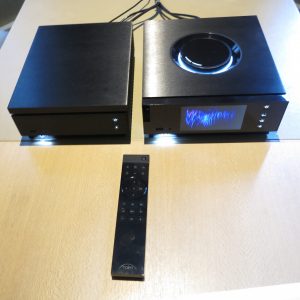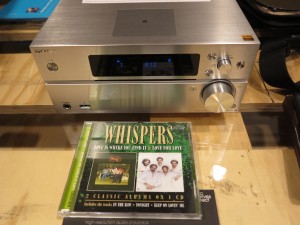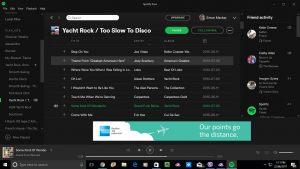A lot of Millenials are preferring to use Spotify or similar “online jukeboxes” as their main music source, having the music play out of a wireless speaker or a network-capable audio system that supports these services.
What are these online jukeboxes?
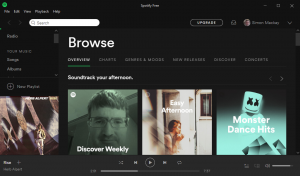
Spotify – the preferred only music source for many Millenials but can be used as a music discovery tool
These “online-jukebox” music services all work work primarily on a subscription basis where you don’t effectively own your music library, rather you stream down the music from these services after you pay a nominal amount per month or year to use these services. Some of them offer a free ad-supported variant of their music service, usually as an on-ramp to the main subscription-funded service.
But some of us, like myself, use the above-mentioned “online jukeboxes” more as a music-discovery tool so we can identify musical content that can fit in to our library. Examples of this include playing playlists that convey particular musical styles or moods, or discovering and “trying out” artists, albums and tracks that pique our interests.It includes situations where a company may offer a branded playlist with songs that represent what they are about.
In my case, I showed some interest in one of the “yacht-rock” playlists on Spotify and there had been a few songs that piqued my interest, some of which would be hard to find on CD in Australia. What I had done was to visit one of the transactional download-to-own music stores that is run as part of a platform’s app store and subsequently bought these songs as audio files that I could download. This meant I could add them as part of a personal playlist that existed on a microSD card as well as on a NAS that is available on the home network.
How can the “download-to-own” music services fit in
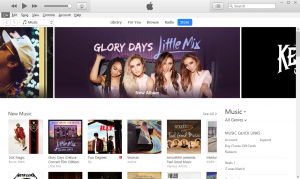
iTunes – still going strong as a download-to-own music store
The way some of us add this content to our libraries is through a transaction-based “download-to-own” service like iTunes or Amazon Music. Increasingly most of the app stores associated with particular regular-computing or mobile platforms like the Windows Store and the Google Play Store are adding “download-to-own” music as part of their offerings.
Such services allow us to buy songs or albums as common media files to download to our computers or NAS drives, with a similar experience to buying the physical media where we effectively own it, but in a digital form. There used to be many of these services before the subscription-based music-streaming services took over the online music marketplace.
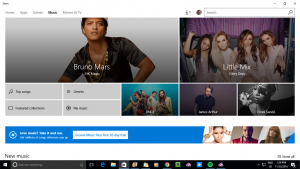
Microsoft Store -Microsoft’s latest entry in to the “download-to-own” scene, providing music as MP3 files
What used to be an advantage was for these services to sell most of the songs as single tracks rather than require the user to buy a complete album. This was very similar to the era of the 7” 45rpm single where people could buy these records for cheap if they are after a particular song. This appealed to people who were buying to build up playlists of particular songs typically to set a particular mood.
There is also the value that you are not dependent on whether the content you like is still available at the online streaming music service or whether you have burnt up your mobile download allowance by streaming your music while on the road. Some of the online music services provide for offline listening but the files that are stored are kept in a proprietary form that can’t be readily played with anything other than the software provided by the online service.
Viable niches that these services can answer
Some of these services still exist but could be taken further to support a range of viable niches whether in the form of content types or audio-reproduction standards.
Answering new and upcoming talent
The typical answer to this issue is to offer these services as an “on-ramp” for upcoming talent like new musicians, basement bands and DJs. Here, these artists who typically have a handful of content but aren’t discovered could be able to sell their content through these services. They offer a simplified “on-ramp” for this kind of talent and may even provide the promotion that it needs to be exposed.
You may find that some of these “download-to-own” music stores will have their “artist and repertoire” teams who “suss out” local gigs, buskers and community radio to hunt down the new talent whose material they can sell.
Supplying particular kinds of content
To the same extent, there are some suppliers who sell particular kinds of “download-to-own” music that suit particular tastes.
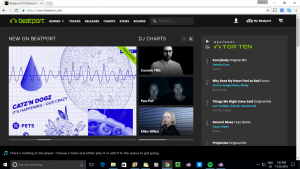
Beatport – the dance-music download-to-own store
One of these is Beatport who sell electronic dance music to DJs and those of us who like that kind of music. This is similar to how some dance-music record stores like Central Station Records in Australia existed, catering to this user class and were pulling out the stops to hunt down the latest beats.
Sometimes some record labels that specialise in particular kinds of content may run their own shopfront instead of or alongside the traditional distribution channels. It may be seen as a way to bypass import controls that some distributors and retailers value highly for controlling what is available in certain markets. As well, this approach effectively provides direct access to the talent the labels represent.
High-quality file-based audio
Another way would be that file types that represent high-quality audio could be available either as a standard or premium option. This can appeal for those of us who value high-quality audio or regularly use a top-notch hi-fi system. As well, there could be the ability to obtain high-quality masterings of the recordings that are available, including the ability to obtain a version prepared with or without high dynamic range.
Here, such recordings can be seen as a premium option for those of us who want something that is more special than what the online streaming services offer. An example of this has been the PonoMusic store that Neil Young started out with but is undergoing some renovation.
How can they complement Spotify and co?
But to continue making sure that these services maintain popular appeal, “download-to-own” music stores that want to cover a large market base have to have access to the current and back catalogue offered by most, if not all, of the major labels across the world. This includes being able to sell these recordings in to other countries, which may raise concern with music labels who don’t like the concept of parallel-importing of content in to other markets.
Similarly, they could partner with the likes of Spotify to offer the recordings that these subscription-based “online jukeboxes” provide for playback as a premium download-to-own option. For example, a media-management program that works with a “download-to-own” store and one of the “online jukeboxes” could offer a “buy this playlist offline” function where you can effectively buy your own copy of a playlist. Here, it would check which of the songs are downloaded or “ripped” from your CDs, then allow you to buy the remainder of the playlist from the “download-to-own” stores.
Conclusion
What has to happen is that, like the way radio and packaged pre-recorded music complemented each other, the download-to-own music services and the “online jukeboxes” of the Spotify kind need to be positioned in a manner to complement each other in the file-based music world.
 Article
Article
